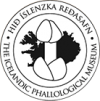Published June 20, 2019
Iceland may be in the midst of a sunny spell, but that doesn’t mean we can’t use some extra Vitamin D. And for that, there’s no better place than The Icelandic Phallological Museum—the most extensive ding-dong-dusted gallery you’ll find in the country, and no doubt, worldwide.

Lances of love
“It basically started as a joke,” Þórður, the manager of the museum, tells me of the origins of the snake filled showroom. “Friends of the founder, Sigurður Hjartarson, had summer jobs at whaling stations and they started giving him severed [meat skewers] from the whales.”
Sigurður quickly developed a passion for these lances of love and began calling farmers from all over the country for specimens. “If a male whale was beached,” Þórður says. “They would call him and he’d drive over with a bucket and an axe and claim the [bone ranger].” He laughs. “So it was done by very meagre means in the beginning.”



Sneaky sausages
But today it’s hard to call The Icelandic Phallological Museum anything but well endowed. Mounted on the walls, preserved in formaldehyde, and masterfully taxidermied, the showroom is packed full of ripe bananas and strong sceptres of all shapes and sizes. It contains specimens from animals as far ranging as walruses to hamsters, and even some human examples, if you’re so inclined.
Walk around, and you’ll be surrounded by Wang Chungs that are taller than yourself, or sneaky sausages that require a magnifying glass to view. In fact, they are so full of one-eyed muscles that they’re currently on the hunt for a bigger space.




Interesting okras
Þórður, who has been working at the museum since 2011, is a font of knowledge of male mammalian anatomy. “This one is an elephant,” he explains, gesturing to a particularly impressive Donkey Kong. “It was a successful taxidermy. Elephants have interesting [okra] as they have tremendous motion control. They can even scratch themselves with it and use it to help them go up hills,” he says.
Currently, the museum’s largest specimens come from whales, but the collection is always expanding, acquiring more foreign donations and home-grown finds. “People hear about us and donate,” he explains. They’ve even been in talks with a man who wants to donate his own soupbone. “He found a doctor in Italy willing to do it, but we actually already have a human specimen,” he says, referring to their famed postmortem donation that was also the subject of a documentary. If models are more your thing, the museum also boasts casts of the entire silver medal-winning Icelandic handball team’s most prized trophies on display.



A gift from the elves
The museum has suffered some tickler tragedies, though. “It’s a quite a shame, there was a beluga whale that got beached in the Westman Islands and we don’t have a beluga yet,” Þórður explains, clearly forlorn. “I was talking to town officials and city workers and if I had been three minutes quicker, I could have talked to the guy who was burying the beluga.”
Overall, though, The Icelandic Phallological Museum is overwhelming in the best possible way. Each specimen is fascinating and you could easily spend hours getting lost learning the peculiarities of each life-giving flame. In the back, they’ve even got a fantasy section full of mystical skin flutes from mermen, elves, and even the Icelandic Christmas lads. How they got these, though, Þórður won’t reveal. All we can say is this: There’s no better place for your daily dose of D than The Icelandic Phallological Museum.













